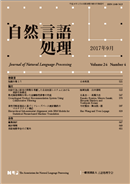Volume 29, Issue 4
Displaying 1-19 of 19 articles from this issue
- |<
- <
- 1
- >
- >|
Preface (Non Peer-Reviewed)
-
2022 Volume 29 Issue 4 Pages 1050-1051
Published: 2022
Released on J-STAGE: December 15, 2022
Download PDF (125K)
General Paper (Peer-Reviewed)
-
2022 Volume 29 Issue 4 Pages 1052-1081
Published: 2022
Released on J-STAGE: December 15, 2022
Download PDF (561K) -
2022 Volume 29 Issue 4 Pages 1082-1105
Published: 2022
Released on J-STAGE: December 15, 2022
Download PDF (380K) -
2022 Volume 29 Issue 4 Pages 1106-1137
Published: 2022
Released on J-STAGE: December 15, 2022
Download PDF (9362K) -
2022 Volume 29 Issue 4 Pages 1138-1164
Published: 2022
Released on J-STAGE: December 15, 2022
Download PDF (1191K) -
2022 Volume 29 Issue 4 Pages 1165-1197
Published: 2022
Released on J-STAGE: December 15, 2022
Download PDF (961K) -
2022 Volume 29 Issue 4 Pages 1198-1232
Published: 2022
Released on J-STAGE: December 15, 2022
Download PDF (5999K)
Technical Report (Peer-Reviewed)
-
2022 Volume 29 Issue 4 Pages 1233-1253
Published: 2022
Released on J-STAGE: December 15, 2022
Download PDF (1131K) -
2022 Volume 29 Issue 4 Pages 1254-1271
Published: 2022
Released on J-STAGE: December 15, 2022
Download PDF (906K)
Society Column (Non Peer-Reviewed)
-
2022 Volume 29 Issue 4 Pages 1272-1278
Published: 2022
Released on J-STAGE: December 15, 2022
Download PDF (277K) -
2022 Volume 29 Issue 4 Pages 1279-1283
Published: 2022
Released on J-STAGE: December 15, 2022
Download PDF (3016K) -
2022 Volume 29 Issue 4 Pages 1284-1289
Published: 2022
Released on J-STAGE: December 15, 2022
Download PDF (446K) -
2022 Volume 29 Issue 4 Pages 1290-1296
Published: 2022
Released on J-STAGE: December 15, 2022
Download PDF (670K) -
2022 Volume 29 Issue 4 Pages 1297-1301
Published: 2022
Released on J-STAGE: December 15, 2022
Download PDF (246K) -
2022 Volume 29 Issue 4 Pages 1302-1307
Published: 2022
Released on J-STAGE: December 15, 2022
Download PDF (204K) -
2022 Volume 29 Issue 4 Pages 1308-1315
Published: 2022
Released on J-STAGE: December 15, 2022
Download PDF (281K) -
2022 Volume 29 Issue 4 Pages 1316-1321
Published: 2022
Released on J-STAGE: December 15, 2022
Download PDF (269K) -
2022 Volume 29 Issue 4 Pages 1322-1329
Published: 2022
Released on J-STAGE: December 15, 2022
Download PDF (719K)
Information (Non Peer-Reviewed)
-
2022 Volume 29 Issue 4 Pages 1330-1335
Published: 2022
Released on J-STAGE: December 15, 2022
Download PDF (308K)
- |<
- <
- 1
- >
- >|
